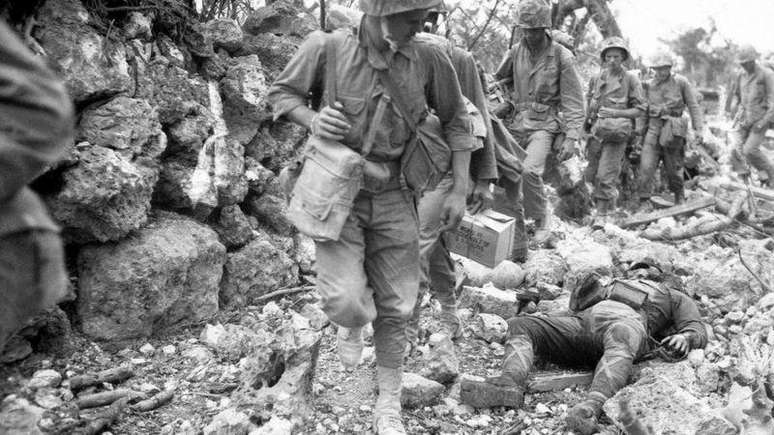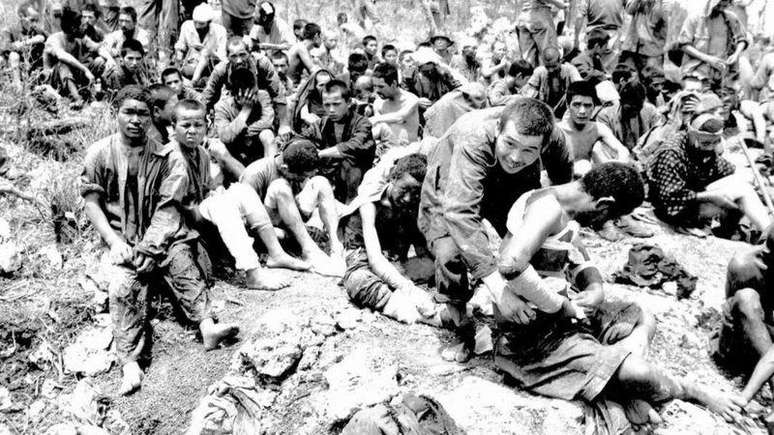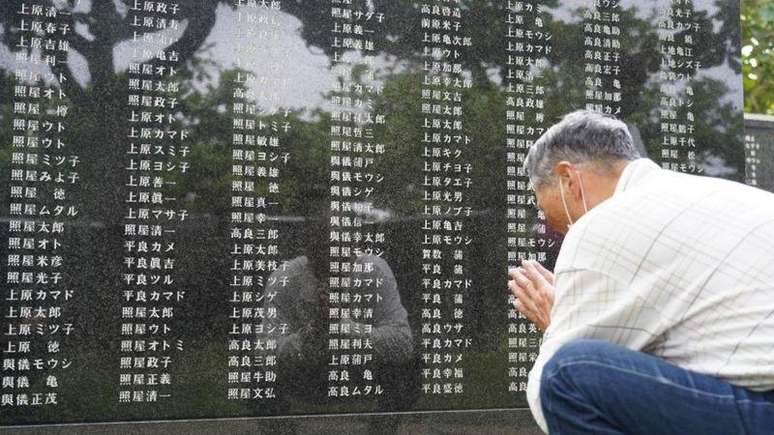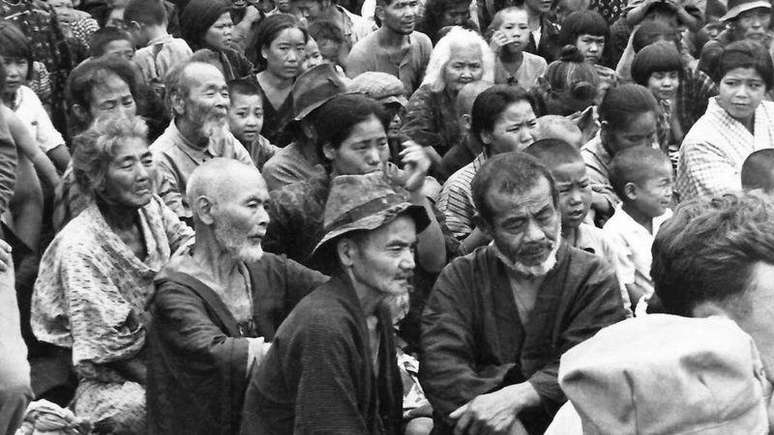In one of the fiercest battles of the Second World War, there was a particularly tragic chapter, with consequences that continue to this day.
Shigeaki Kinjo was 16 when hundreds of people in his archipelago in Japan started killing each other. And he made a decision that would mark him for life.
During World War II, Kinjo and other Ryukyu Islanders were indoctrinated with the idea that if American troops invaded the territory, they would be cruelly murdered and women raped.
At that time, the idea was instilled that, rather than face this terrible end, it would be better for the citizens to end their lives. The Imperial Japanese Army even provided civilians with hand grenades to throw at enemies or blow themselves up, but many of them failed.
When the American soldiers landed, Kinjo saw an adult from his village beat his family to death with a tree branch and decided to do exactly the same.
“We thought it was the only way out we had,” Kinjo recalled years later. “With my older brother, we killed my mother, my sister and my younger brother,” he said during a 1998 interview with the UK’s Imperial War Museum.
That was the beginning of a wave of forced civilian suicides that took place during the Battle of Okinawa, the fierce fighting that began on April 1 (as it is today) and was key to ending the war in 1945.
But to understand how such a tragedy happened 78 years ago, a little context is needed.
“We all wanted to commit suicide”
Located hundreds of kilometers southwest of Tokyo, Okinawa is the largest of the Ryukyu Islands, which once formed an independent kingdom and became an integral part of Japan in 1879.
This past is usually associated with the fact that the island was the scene of one of the bloodiest battles in the Pacific during World War II.

“Residents of the archipelago believe what happened at the Battle of Okinawa was unique, because they weren’t seen as completely Japanese,” says historian Kirsten Ziomek, who heads a department of Asian studies at Adelphi University in the United States. and is writing a book about the experiences of local people during the war in the Pacific.
Days after invading the Kerama Islands, where Kinjo lived, the Allies began capturing Okinawa to provide a strategic platform from which to launch an eventual invasion of the rest of Japan — which, in turn, responded with a series of suicidal airstrikes . pilots against the American fleet to the west and held out with tens of thousands of ground troops, often using caves as bomb shelters.
In the 82 days of fighting on Okinawa, an estimated 100,000 Japanese soldiers, 12,000 US servicemen and at least 100,000 civilians died, including hundreds who were forced to commit suicide.

Ziomek argues that the key to the mass suicides is that they occurred in locations with a Japanese military presence, such as an island cave. Meanwhile, in other places that only had civilians, there was another general understanding: it was better to surrender.
“The forced gang suicides, in which hundreds of people die, occurred because the Japanese military was forcing civilians to do it,” Ziomek explains. “It’s horrible what happened.”
The exact number of civilians who took their lives in the Battle of Okinawa has never been established.
Historian Hirofumi Hayashi estimates that there were 559 victims of mass suicides in the Kerama Islands alone. Estimates suggest that, when added to Okinawa, there were about 700 such deaths in total.
Some experts suggest that Japanese media propaganda, which portrayed Americans as savages and glorified civilian suicides in the 1944 Battle of Saipan, the largest of the Mariana Islands, may also have influenced many on Okinawa to take their own lives.

Several survivors of this episode agree in underlining the Japanese military’s responsibility for encouraging civilian suicide, either out of fear of what they might say to the invaders or because in local culture it was considered shameful to take prisoners.
One defender of this thesis was Takejiro Nakamura, who saw his mother strangling his sister with a rope after she begged to die first.
“We all wanted to commit suicide because we believed in the imperial army,” Nakamura justified in a statement collected by the BBC in 2007. “I blame the imperial army. My sister would have children and grandchildren today.”
Another survivor, Mitsuoko Oshiro, recalled how a soldier gave her a grenade and told her that if she didn’t use it to kill herself and her family, she would be raped and tortured by the Americans.
“I wanted to die, but I couldn’t. We fled to the hills when the Americans invaded, but they didn’t hurt us, they just let us go,” he said.
However, 11 of Oshiro’s family members obeyed orders and died from taking rat poison.
lasting consequences
The fact that these testimonials appeared in 2007 is far from a mere coincidence.
Controversy erupted that year after the Japanese government proposed amending and softening passages in school textbooks that claimed the army had ordered Okinawans to commit suicide rather than surrender.
Some Japanese conservatives have questioned reports of the country’s brutal wartime past for years.
But the proposed change to history textbooks for high school students sparked one of the largest protests ever seen on the island: more than 100,000 people took to the streets to demonstrate opposition to the revision.

Kinjo has been one of the best-known voices in these protests. She testified of her wartime experience in the trials leading to the acknowledgment of the Japanese military’s involvement in mass suicides.
It was quite an accomplishment for someone like Kinjo who, after surviving the battle and being taken prisoner by the Americans, took two decades to start recounting what he had experienced. He died in July last year, aged 93, of heart problems.
The book controversy showed the extent to which forced mass suicides remained a sensitive issue in Okinawa.
After surrendering during the war, Japan relinquished control of Okinawa to the United States until 1972, although US military bases on the island also caused controversy and protests.
One question with an uncertain answer is whether civilian suicides on Okinawa in any way influenced the United States’ decision to drop nuclear bombs on Hiroshima and Nagasaki in August 1945 to defeat Japan and end World War II.
Ziomek points out that the incidents in Saipan, in which civilians leapt off cliffs en masse to avoid surrender, and Okinawa contributed to the idea that the United States was facing an unusual enemy that would never surrender or stop.
“And how [esses fatos] fueled the justification for dropping the atomic bomb,” he explains.
“However, I doubt the bomb would have been dropped had these forced mass suicides not taken place.”
– This text was published in https://www.bbc.com/english/articles/cm5dl5x8yd7o
Source: Terra
Rose James is a Gossipify movie and series reviewer known for her in-depth analysis and unique perspective on the latest releases. With a background in film studies, she provides engaging and informative reviews, and keeps readers up to date with industry trends and emerging talents.


![Everything starts here: What awaits you on May 13, 2025, on Tuesday, 1174 episodes of 1374 [SPOILERS] Everything starts here: What awaits you on May 13, 2025, on Tuesday, 1174 episodes of 1374 [SPOILERS]](https://fr.web.img2.acsta.net/img/c5/5c/c55cb027831848dfcf9440f50d04e75b.jpg)




